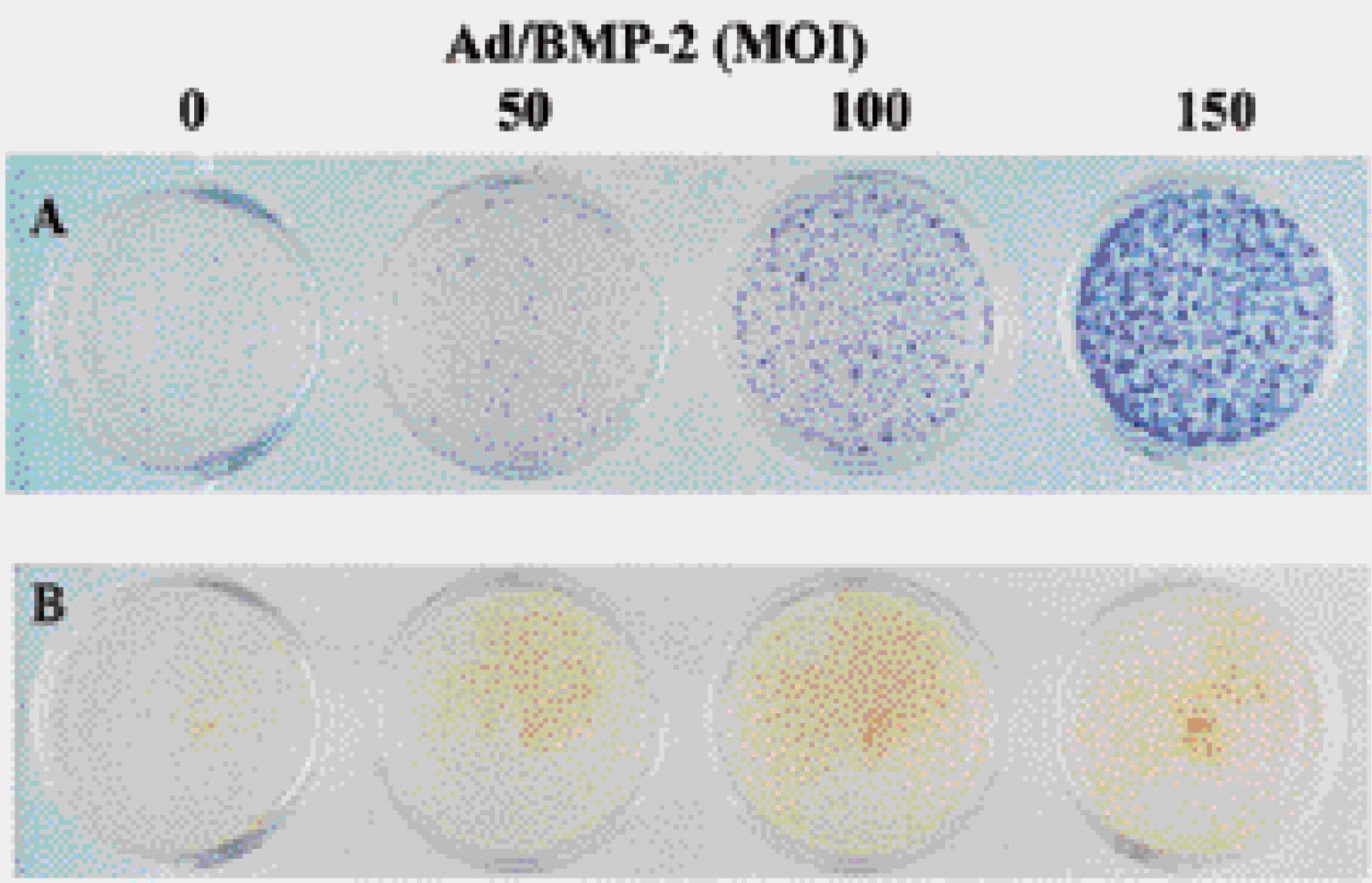Abstract
Study Design
A n in-vitro experiment using human ligamentum flavum (LF) and the adnovirus- BMP- 2 construct, A d/ BMP- 2.
Objectives
To determine the dual roles of LF as an osteoinductive agent and carrier for ex- vivo gene transfer.
Summary of Literature Review
LF is known to have osteogenic potential. Pathologically, ossified LF may cause myelopathy and radiculopathy. BMP- 2 is known as an important factor in the differentiation, and maintenance, of osteoblast phenotypes. Ex- vivo gene transfer, using human LF for spinal fusion, has never been attempted before.
Materials and Methods
The LF cells were cultured from the degenerated LF of spinal stenosis patients. A n adenovirus construct, containing BMP- 2 cDNA (A d/BMP- 2), was also produced. The LF cell cultures were exposed to the adenoviral construct. The Osteocalcin expression was analysed by W estern blot analysis. The osteocalcin and BMP- 2 mRNA expressions were analysed by RT- PCR. Bone formation was assessed by alkaline phosphatase and Von Kossa stains.
Results
The LF cell cultures, with A d/BMP- 2, showed transgene expression in the Western blot analysis. A lso, the cultures exhibited the mR NA expressions of both osteocalcin and BMP- 2, in a dosedependent manner. The LF cultures, with A d/BMP- 2, demonstrated alkaline phosphatase expression and bone nodule formations from the Von Kossa staining.
Go to : 
REFERENCES
1). Hayashi K., Ishidou Y., Yonemori K. Expression and localization of bone morphogenetic proteins (BMPs) and BMP receptors in ossification of the ligamentum flavum. Bone,. 21:23–30. 1997.

2). Hoshi K., Amizuka N., Sakou T., Kurokawa T., Ozawa H. Fibroblasts of spinal ligaments pathologically differentiate into chondrocytes induced by recombinant human bone morphogenetic protein-2: morphological examinations for ossification of spinal ligaments. Bone,. 21:155–62. 1997.

3). Israel DI., Nove J., Kerns KM., Moutsatsos IK., Kaufman RJ. Expression and characterization of bone morphogenetic protein-2 in Chinese hamster ovary cells. Growth Factors,. 7:139–50. 1992.

4). Mimatsu K., Kishi S., and Hashizume Y. Experimental chronic compression on the spinal cord of the rabbit by ectopic bone formation in the ligamentum flavum with bone morphogenetic protein. Spinal Cord,. 35:740–6. 1997.

5). Moon SH., Kim H., Kwon EH., Won JH., Kim HS., Hahn SB, et al. Osteogenesis by transfer of bone morphogenetic protein-2 cDNA in ligamentum flavum cells: Approach toward tissue engineering. J Kor Spine Surg,. 9:263–269. 2002.

6). Saito H., Mimatsu K., Sato K., Hashizume Y. Histopathologic and morphometric study of spinal cord lesion in a chronic cord compression model using bone morphogenetic protein in rabbits. Spine,. 17:1368–74. 1992.

7). Specchia N., Pagnotta A., Gigante A., Logroscino G., and Toesca A. Characterization of cultured human ligamnet flavum cells in lumbar spine stenosis. J Orthop Res,. 19:294–300. 2001.
8). Takuwa Y., Ohse C., Wang EA., Wozney JM., Yamashita K. Bone morphogenetic protein-2 stimulates alkaline phosphatase activity and collagen synthesis in cultured osteoblastic cells, MC3T3-E1. Biochem Biophys Res Commun,. 174:96–101. 1991.

9). Viggeswarapu M., Boden SD., Liu Y., Hair GA., Louis-Ugbo J., Murakami H, et al. Adenoviral delivery of LIM mineralization protein-1 induces new-bone formation in vitro and in vivo. J Bone Joint Surg Am,. 83-A:364–76. 2001.

10). Wang EA., Rosen V., Cordes P., Hewick RM., Kriz MJ., Luxenberg DP, et al. Purification and characterization of other distinct bone-inducing factors. Proc Natl Acad Sci U S A,. 85:9484–8. 1988.

11). Wang EA., Rosen V., D'Alessandro JS., Bauduy M., Cordes P., Harada T, et al. Recombinant human bone morphogenetic protein induces bone formation. Proc Natl Acad Sci U S A,. 87:2220–4. 1990.

Go to : 
 | Fig. 1.Transgene expression (BMP-2 mRNA) and expression of osteogenic phenotype (osteocalcin mRNA) in cell culture of ligamentum flavum with an Ad/BMP-2 (MOI of 50, 100, 150). Expression was detected by reverse transcriptase polymerase chain reaction. |
 | Fig. 2.Expression of osteocalcin protein in supernatant of ligamentum flavum cell culture with an Ad/BMP-2 (MOI of 50, 100, 150). Expression was detected by Western Blot analysis. Negative control denotes CHO cell without Ad/BMP-2 and positive control denotes saline with osteocalcin protein. |




 PDF
PDF ePub
ePub Citation
Citation Print
Print



 XML Download
XML Download